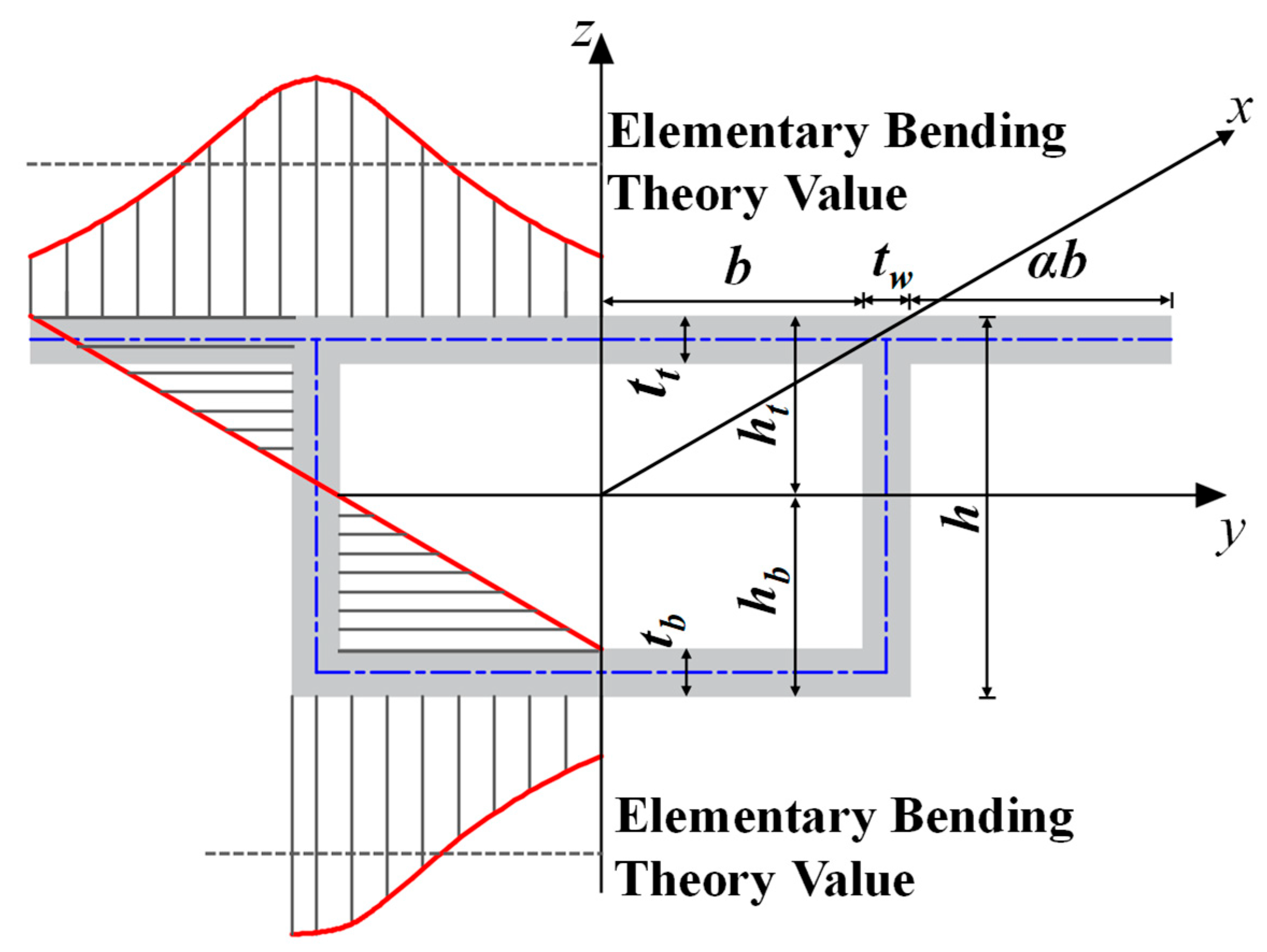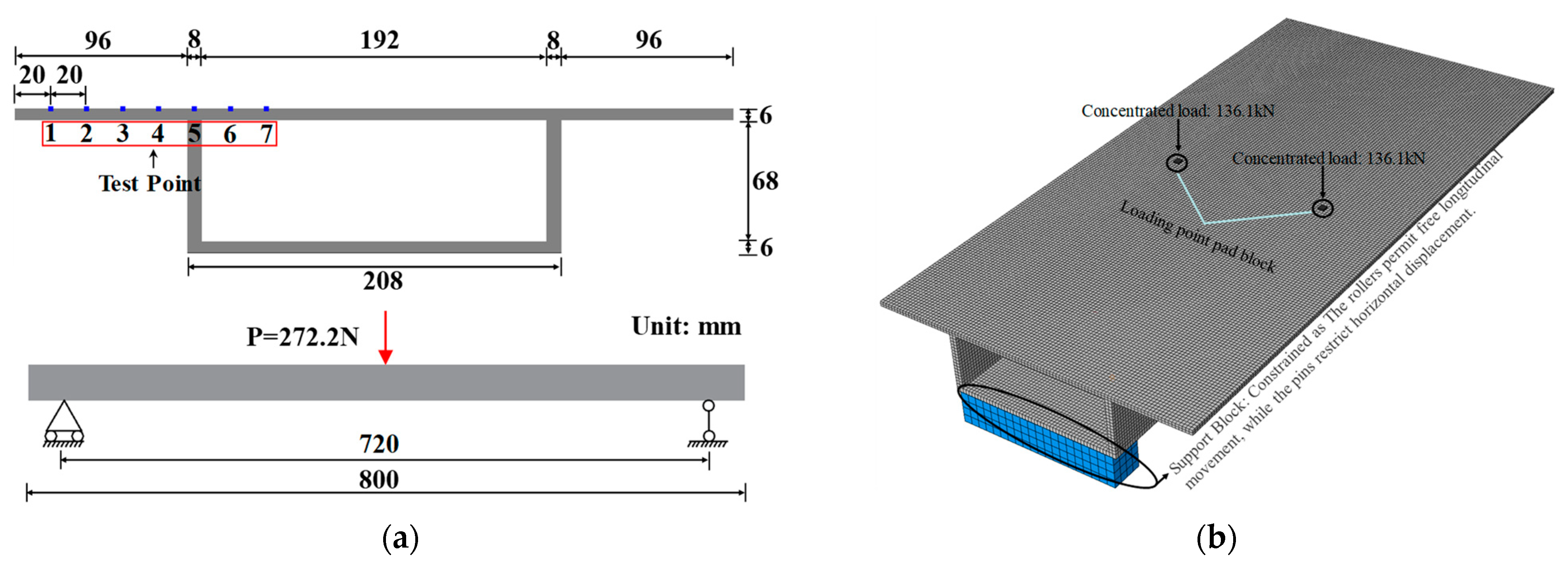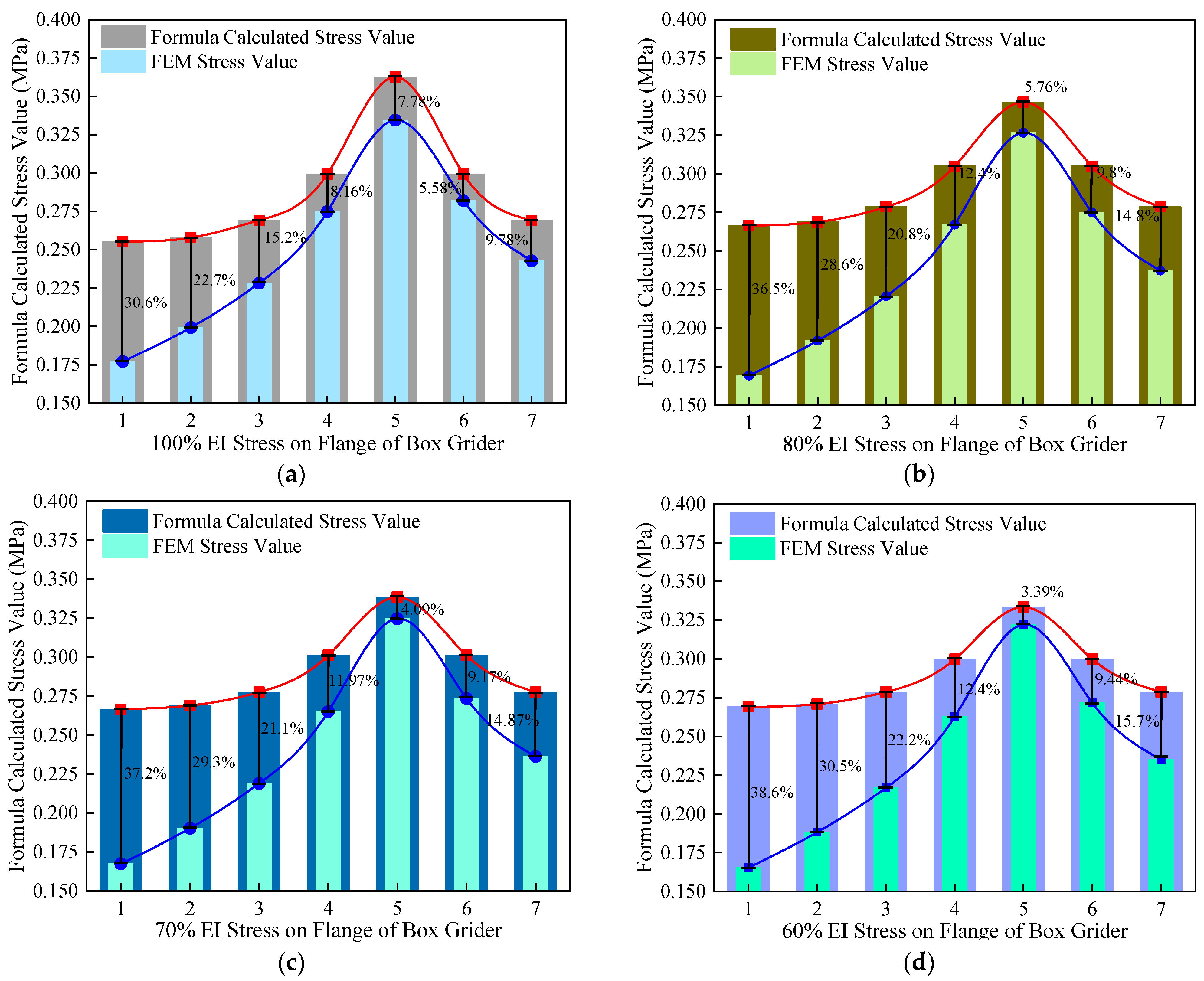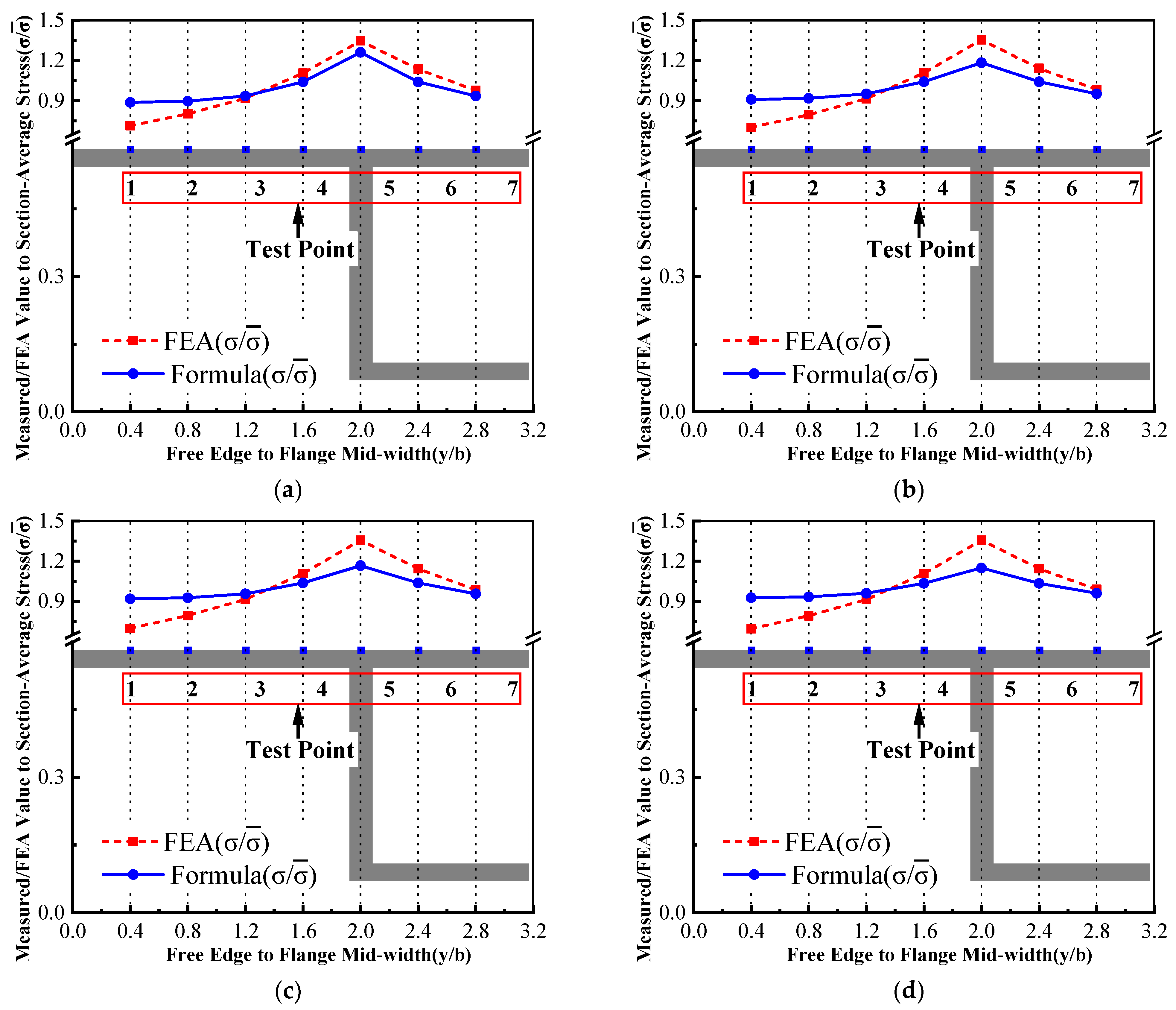Study on the Shear Lag Calculation Method for Damaged Box Girder
Abstract
1. Introduction
2. Stepped Stiffness Modeling and Deflection Influence Line
2.1. Stepped Stiffness Modeling
2.2. Deflection Influence Lines
2.3. Stiffness-Reduction Coefficient in the Damaged Segment of the Beam
3. Derivation of the Shear Lag Variational Equation for Damaged Box Girders
3.1. Potential Energy Equation and Individual Strain Energies
3.2. Shear Lag Differential Equation and Solution
3.3. Bending Stress Expression
4. Real Bridge Load Testing and FEM Analysis
4.1. Bridge Load Testing Procedure Brief Description
4.2. Finite Element Model (FEM) of Box Girder
5. Results of Real Bridge Test Data and FEM Analysis
6. Discussion
7. Conclusions
- This study quantifies damage in box girders through a stiffness-reduction coefficient , derived from (1) the principle of minimum potential energy and classical shear lag theory and (2) a stepped stiffness model incorporating crack statistics. The proposed method establishes a relationship between and differences in deflection influence lines. It accurately identifies damage locations, as sharp peaks in the second derivatives of the deflection influence lines correspond to predefined damage zones at the midspan. These results demonstrate the effectiveness of the influence line approach for damage localization.
- Based on field inspections, design codes, and relevant literature, this study defined three levels of structural damage and conducted FEM analyses on plexiglass box girder models. The relative error (RE) between the FEM and theoretical results remained within 10% for inner flange points (Points 4–7) under stiffness reductions ranging from 0% to 40%. The maximum error was observed at Point 1, located near the free edge, where the RE reached approximately 38%. After normalizing the data using dimensionless parameters and , the FEM and theoretical curves converged for , indicating that the global bending moment equilibrium was well maintained. Discrepancies were primarily concentrated in the shear lag-affected boundary region near the free edge ().
- Based on deflection measurements from completion and load tests, according to Equations (13) and (17), the midspan equivalent stiffness reduced to 81.06%. FEM back-analysis showed a 3.08% deviation, validating the field inspection applicability of the theory. At 81% stiffness, field-measured normal stresses showed 5.73%~13.61% relative error. Global error metrics confirm the validity of the theory.
- Theoretical stresses consistently exceeded FEM results by 3–10%, indicating conservative safety margins in the proposed shear lag theory. However, current methods omit web shear deformation and higher-order warping at free edges, causing larger errors in flange tips.
Author Contributions
Funding
Data Availability Statement
Acknowledgments
Conflicts of Interest
Appendix A
Appendix B. Symbol Table
| Symbol | Name/Quantity | Units |
| Elastic modulus | Units | |
| Shear modulus | MPa | |
| Poisson’s ratio | MPa | |
| Flexural stiffness (intact) | — | |
| EI′ | Flexural stiffness (damaged) | N·m2 |
| Stiffness-reduction coefficient | N·m2 | |
| Stiffness allocation coefficient | — | |
| Damage index | — | |
| Deflection | — | |
| Baseline deflection | mm | |
| Additional deflection | mm | |
| Bending moment | mm | |
| Shear force | kN·m | |
| Nominal curvature | kN | |
| Average crack height | — | |
| Average crack spacing | mm | |
| Total crack width | mm | |
| Flange longitudinal displacement | mm | |
| Max. rotation difference | mm | |
| Shear-lag eigen parameter | mm | |
| Flange width | 1/m2 | |
| Centroid to flange mid-surface | mm | |
| , | Flange thickness | mm |
| Flange moment of inertia | mm⁴ | |
| Web moment of inertia | mm⁴ | |
| Span length | mm | |
| Moving load position | m | |
| Unit load position | m | |
| Concentrated load | m | |
| Load on middle girder | kN | |
| Nominal tensile strain | 1/m |
References
- Lin, Z.; Zhao, J. Revisit of AASHTO Effective Flange-Width Provisions for Box Girders. J. Bridge Eng. 2011, 16, 881–889. [Google Scholar] [CrossRef]
- Qin, X.X.; Liu, H.B.; Wang, S.J.; Yan, Z.H. Symplectic Analysis of the Shear Lag Phenomenon in a T-Beam. J. Eng. Mech. 2015, 141, 04014157. [Google Scholar] [CrossRef]
- Zhou, S. Shear Lag Analysis in Prestressed Concrete Box Girders. J. Bridge Eng. 2011, 16, 500–512. [Google Scholar] [CrossRef]
- Zhang, Y. Improved Finite-Segment Method for Analysing Shear Lag Effect in Thin-Walled Box Girders. J. Struct. Eng. 2012, 138, 1279–1284. [Google Scholar] [CrossRef]
- Li, Y.; Xie, J.; Wang, F.; Li, Y. Shear Lag Effect of Ultra-Wide Box Girder under Influence of Shear Deformation. Appl. Sci. 2024, 14, 4778. [Google Scholar] [CrossRef]
- He, X.; Xiang, Y.; Qiu, X.; Chen, Z. Shear Lag Including Axial Balance of Box Beams by Finite-Segment Model. J. Constr. Steel Res. 2022, 189, 107043. [Google Scholar] [CrossRef]
- Wang, C.S.; Zhang, W.T.; Li, H.T.; Zhai, X.L.; Xin, Y.F. Shear Lag Effect of Twin I-Shaped Composite Girders in Cable-Stayed Bridges. Thin-Walled Struct. 2022, 180, 109822. [Google Scholar] [CrossRef]
- Zhou, P.; Lin, P. Finite-Segment Method of Shear Lag Analysis of Continuous Box Girders with Variable Height. J. Railw. Sci. Eng. 2018, 15, 948–955. [Google Scholar] [CrossRef]
- Cen, F.; Gan, Z.; Gao, P. Analysing Shear lag Warping Displacement Functions and Mechanical Characteristics of Rectangular Concrete Box-Girder Bridges. ZAMM—J. Appl. Math. Mech. 2025, 105, e202400676. [Google Scholar] [CrossRef]
- Li, X.; Wan, S.; Shen, K.; Zhou, P.; Wang, X. Prediction of Shear Lag Effect in Thin-Walled Single-Box Multicell Box Girder Based on the Modified Warping Displacement Function. Adv. Civ. Eng. 2020, 2020, 6815092. [Google Scholar] [CrossRef]
- Cao, G.; Fang, Z. Shear Lag Effect of Cracked Simply Supported Box Girder Analysed by Variational Principle. Chin. J. Comput. Mech. 2007, 24, 853–858, 864. [Google Scholar] [CrossRef]
- He, Z.; Liu, Y.; Zhou, P.; Lin, P. Analysis on Shear Lag Effect of Concrete Box Girder after Cracking. Railw. Eng. 2017, 57, 25–30. [Google Scholar]
- Samani, M.A.; Farrokhabadi, A.; Boora, S.H. Determining a Closed-Form Relation for Evolution of Crack Density and Induced Delamination in Off-Axis Composite Laminates under Uniaxial Loading Condition. Mech. Adv. Mater. Struct. 2020, 27, 859–868. [Google Scholar] [CrossRef]
- Wang, X. Study on Damage Identification of Urban Simply Supported Beam Bridge Based on the Deflection Influence Line. Master’s Thesis, Southwest University of Science and Technology, Mianyang, China, 2017. [Google Scholar]
- Zhang, J.; Dong, J.; Li, G.; Zhu, S.; Wang, X. Study on Damage Identification of Continuous Girder Bridge Structure Model Based on Influence Line. Build. Struct. 2021, 51, 1451–1455. [Google Scholar]
- Zhou, Y.; Li, M.; Shi, Y.; Xu, C.; Zhang, D.; Zhou, M. Research on Damage Identification of Arch Bridges Based on Deflection Influence Line Analytical Theory. Buildings 2024, 14, 6. [Google Scholar] [CrossRef]
- Wang, L.; Zhao, Y. Analysis of Residual Bearing Capacity of Cracked Prestressed Concrete Continuous Box Bridges. J. Railw. Sci. Eng. 2015, 12, 127–131. [Google Scholar] [CrossRef]
- Huang, H.; He, P.; Zhou, F.; Tan, Y. Flexural Behaviour Test and Normal-Section Bearing Capacity of RC Beam Strengthened with Aluminium Alloy Plate. J. Highw. Transp. Res. Dev. 2024, 41, 105–115, 125. [Google Scholar]
- Ma, Z.; Wu, X.; Chang, X.; Huang, J. Concrete Bridge Bearing Capacity Degradation Based on Crack Patterns. J. Highw. Transp. Res. Dev. 2024, 41, 154–161. [Google Scholar]
- Dong, S. Model Experimental Study of Deflection of the Cracked Prestressed Concrete Beam. Master’s Thesis, Chang’an University, Xi’an, China, 2010. [Google Scholar]
- Wu, X.; Qian, R.; Su, P. Calculation of Transverse Distribution of Assembled T-Beam Bridge Considering Stiffness Damage. J. Highw. Transp. Res. Dev. 2018, 35, 61–66. [Google Scholar]
- Li, M.; Zhang, D.; Liu, R. Damage Identification of Simply Supported Beams Based on Deflection Influence Line Difference Curvature. J. Nanyang Inst. Technol. 2023, 15, 90–94. [Google Scholar] [CrossRef]
- Luo, Q. Theoretical and Model Test Studies of the Shear Lag in Thin-Walled Box Girders Based on Energy Principle. Ph.D. Thesis, Hunan University, Changsha, China, 2005. [Google Scholar]
- Luo, Q. Analysis of the Shear Lag Effect on Continuous Box Girder Bridges with Variable Depth. China J. Highw. Transp. 1998, 1, 65–72. [Google Scholar] [CrossRef]
- Xu, X.; Zhang, F.; Wei, C. Stiffness Damage Assessment of Prestressed Concrete Box-Girder after Cracking. Eng. Mech. 2015, 32, 95–102. [Google Scholar]
- Xu, X.; Ye, W.; Qiang, S. Torsion and Distortion Analysis of Thin-Walled Box Girder with Cantilever Flanges. J. China Railw. Soc. 2015, 37, 83–91. [Google Scholar] [CrossRef]
- Vukoja, H.; Vlašić, A.; Srbić, M. Shear Lag Effect on Box Steel Beams with Wide Curved Flanges. Appl. Sci. 2024, 14, 8481. [Google Scholar] [CrossRef]
- Zhu, D.; Huang, N.; Li, J.; Zhou, S.; Wu, C. Shear Lag Analysis of Simply Supported Box Girders Considering Axial Equilibrium and Shear Deformation. Buildings 2023, 13, 2415. [Google Scholar] [CrossRef]









| Member ID | Damage Location | Damage Type | Damage Size |
|---|---|---|---|
| 6# | Flange plate | Concrete spalling with exposed reinforcement | 0.6 m × 1 m |
| 2# | Flange plate | Concrete spalling with exposed reinforcement | 0.4 m × 0.1 m × 0.08 m |
| 2# | Outer web, midspan | Transverse cracks | 4 cracks: ; ; ; |
| 3# | Outer web, midspan | Longitudinal crack |
| Boundary Conditions | Position | Physical Implications | Engineering Interpretation |
|---|---|---|---|
| Left side of the beam: x = 0 | Slope of shear lag is zero | At the support (or symmetry plane), the additional axial strain from shear lag is zero; warping is fully restrained. | |
| Left side of the beam: x = 0 | Repeat for the adjacent half-span | The second web/half-span has the same zero shear lag strain at the support, ensuring symmetric boundary restraint. | |
| Midpoint: | Displacements are continuous | The additional axial displacements of the two segments are continuous at midspan, preventing longitudinal mismatch or opening. | |
| Midpoint: | Shear lag slope + bending correction | Continuity of “shear lag slope + bending correction” at the interface keeps shear flow and axial force balanced without jumps. |
| 81.06% EI | Calculated Point | ||
|---|---|---|---|
| 1 | 2 | 3 | |
| Test value (MPa) | 2.645 | 2.936 | 3.523 |
| Calculated value (MPa) | 3.025 | 3.166 | 3.683 |
| RE | 13.61% | 8.22% | 5.73% |
| MSE | 0.074 | ||
| RMSE | 0.273 | ||
| NRMSE | 0.090 | ||
| COV | 0.101 | ||
| Setting Stiffness Reduction | Stress of Test Point (MPa) | Test Point Code | ||||||
|---|---|---|---|---|---|---|---|---|
| 1 | 2 | 3 | 4 | 5 | 6 | 7 | ||
| 0% | FEA | 0.1772 | 0.1993 | 0.2282 | 0.2748 | 0.3344 | 0.2819 | 0.2428 |
| Formula | 0.2553 | 0.2579 | 0.2691 | 0.2992 | 0.3626 | 0.2992 | 0.2691 | |
| RE | 30.60% | 22.73% | 15.21% | 8.16% | 7.78% | 5.78% | 9.78% | |
| 20% | FEA | 0.1692 | 0.1918 | 0.2206 | 0.2671 | 0.3266 | 0.2751 | 0.2372 |
| Formula | 0.2663 | 0.2687 | 0.2785 | 0.3050 | 0.3465 | 0.3050 | 0.2785 | |
| RE | 36.48% | 28.63% | 20.79% | 12.44% | 5.76% | 9.80% | 14.86% | |
| 30% | FEA | 0.1674 | 0.1901 | 0.2189 | 0.2651 | 0.3245 | 0.2736 | 0.2363 |
| Formula | 0.2667 | 0.2690 | 0.2775 | 0.3012 | 0.3384 | 0.3012 | 0.2775 | |
| RE | 37.24% | 29.32% | 21.12% | 11.98% | 4.09% | 9.17% | 14.87% | |
| 40% | FEA | 0.1653 | 0.1883 | 0.2169 | 0.2628 | 0.3221 | 0.2717 | 0.2350 |
| Formula | 0.2691 | 0.2709 | 0.2788 | 0.3000 | 0.3334 | 0.3000 | 0.2788 | |
| RE | 38.57% | 30.51% | 22.21% | 12.38% | 3.39% | 9.44% | 15.72% | |
| Setting Stiffness Reduction | MSE | RMSE | NRMSE | COV |
|---|---|---|---|---|
| 0% | 0.0019 | 0.0441 | 0.28 | 0.131 |
| 20% | 0.0033 | 0.0575 | 0.365 | 0.097 |
| 30% | 0.0034 | 0.0579 | 0.368 | 0.088 |
| 40% | 0.0037 | 0.0605 | 0.386 | 0.079 |
Disclaimer/Publisher’s Note: The statements, opinions and data contained in all publications are solely those of the individual author(s) and contributor(s) and not of MDPI and/or the editor(s). MDPI and/or the editor(s) disclaim responsibility for any injury to people or property resulting from any ideas, methods, instructions or products referred to in the content. |
© 2025 by the authors. Licensee MDPI, Basel, Switzerland. This article is an open access article distributed under the terms and conditions of the Creative Commons Attribution (CC BY) license (https://creativecommons.org/licenses/by/4.0/).
Share and Cite
Zhang, Y.; Wang, J.; Wu, X.; Yin, J.; Shi, Y. Study on the Shear Lag Calculation Method for Damaged Box Girder. Buildings 2025, 15, 1901. https://doi.org/10.3390/buildings15111901
Zhang Y, Wang J, Wu X, Yin J, Shi Y. Study on the Shear Lag Calculation Method for Damaged Box Girder. Buildings. 2025; 15(11):1901. https://doi.org/10.3390/buildings15111901
Chicago/Turabian StyleZhang, Yulong, Junguang Wang, Xiaoguang Wu, Jiahao Yin, and Yuanxu Shi. 2025. "Study on the Shear Lag Calculation Method for Damaged Box Girder" Buildings 15, no. 11: 1901. https://doi.org/10.3390/buildings15111901
APA StyleZhang, Y., Wang, J., Wu, X., Yin, J., & Shi, Y. (2025). Study on the Shear Lag Calculation Method for Damaged Box Girder. Buildings, 15(11), 1901. https://doi.org/10.3390/buildings15111901






